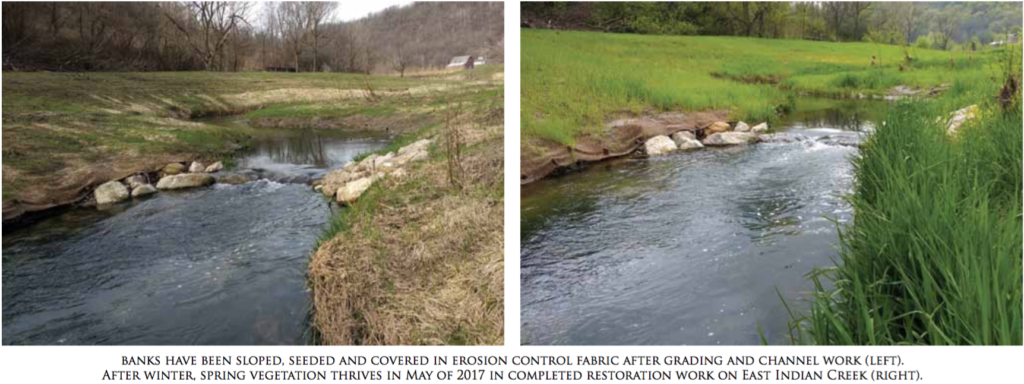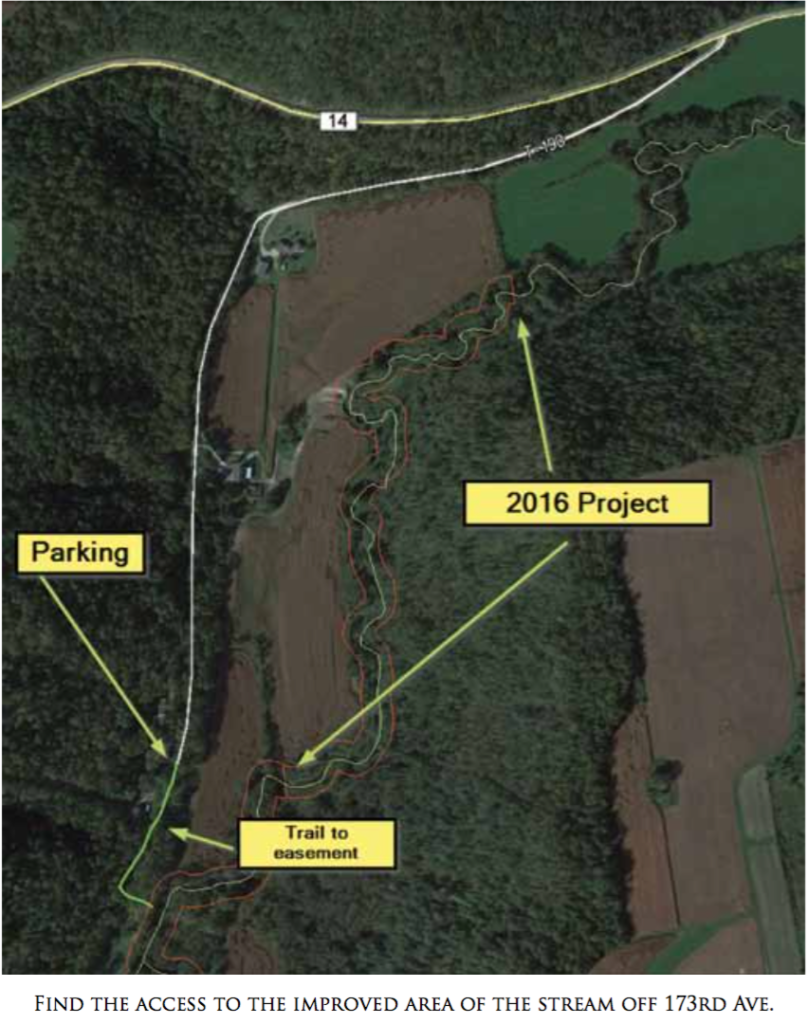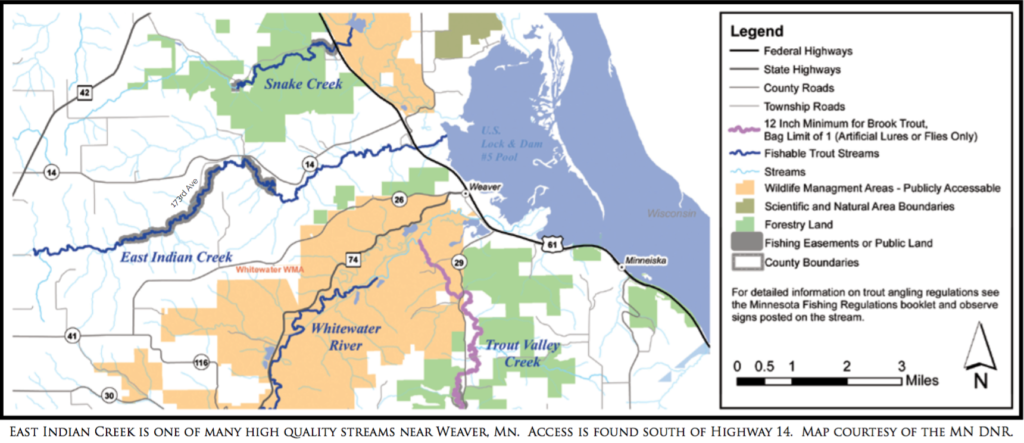Fishing Our Habitat Work: East Indian Creek
Exploring a Brook Trout Gem in Minnesota’s Driftless
by Paul Krolak
 Tucked in a valley northeast of Plainview and the next valley over from the Whitewater, East Indian Creek is a little gem of a trout stream. A small stream in a beautiful valley, the creek drains into the Mississippi backwaters just upstream from Weaver.
Tucked in a valley northeast of Plainview and the next valley over from the Whitewater, East Indian Creek is a little gem of a trout stream. A small stream in a beautiful valley, the creek drains into the Mississippi backwaters just upstream from Weaver.
Hiawatha TU and Minnesota TU have completed two Lessard-Sams funded stream restoration projects on East Indian. The latest, completed in 2016, is on the upper end of the creek.
To find East Indian Creek and the 2016 project, take MN 42 north out of Plainview and turn right on Wabasha Cty 14 East towards the Mississippi River. A few miles later, you’ll see an 8% grade sign and begin your descent towards the valley floor. Just shy of the bottom of the hill on the right or south side is 173rd Avenue which curves back along the valley wall. Follow that about a mile past the big barn and you’ll come to a place where the road widens out with a cluster of buildings, including two small cabins on the downhill side of the road.
 Without blocking the driveway that continues on from that point, park along the downhill side. There’s a sign, leaning against a tree last I was there, indicating “East Indian Creek Access” and “Walk up the road from this point.”
Without blocking the driveway that continues on from that point, park along the downhill side. There’s a sign, leaning against a tree last I was there, indicating “East Indian Creek Access” and “Walk up the road from this point.”
Gear up and follow the road to a horse pasture and you’ll see signs indicating a trail to the stream easement. The easement goes downstream quite a ways, well beyond the barn you passed earlier and upstream almost to the headwaters.
At the easement access, the stream is in a relatively rough state. The stream corridor is mostly wooded with high banks typical of unrestored stream reaches. There are fish to be found but you’ll contend with overhanging trees and brush.
The 2016 project starts about one hundred yards downstream of the easement trail. You’ll know you’re there when the stream corridor opens up and the banks are sloped back. The project continues downstream about a mile to the end of the angling easement. Again, you’ll know you’re there because the trees close back in and the banks get tall. There’s also the small beige easement stop sign, but the change in condition is obvious. The project area had a fair amount of tilled acreage but as of 2016, the land adjacent to the project went into the Conservation Reserve Program (CRP, and only a few wildlife food plots are being tilled.)
When the restoration design for the proj- ect was discussed, it was noted by the MNDNR Lake Cities Fisheries Sta that the brook trout living in East Indian are a genetically special strain. While they can’t claim they’re true natives, they don’t seem to show much in uence from the eastern brook trout seen in other brook trout populations.
 Restoration objectives included lowering the high dirt banks, narrowing the stream where it had over-widened, and adding rock and wood habitat features. Larry Gates, the former Lake Cities Fisheries Supervisor, valley landowner and watershed champion accompanied the TU and Fisheries personnel on the conceptual review. He emphasized ‘tactile’ cover: deeply placed wood and rock that the trout can nestle up against or under to avoid predators.
Restoration objectives included lowering the high dirt banks, narrowing the stream where it had over-widened, and adding rock and wood habitat features. Larry Gates, the former Lake Cities Fisheries Supervisor, valley landowner and watershed champion accompanied the TU and Fisheries personnel on the conceptual review. He emphasized ‘tactile’ cover: deeply placed wood and rock that the trout can nestle up against or under to avoid predators.
The preliminary restoration plan was drawn up by Melissa Konsti of the MNDNR Fisheries. Final plans, permitting and construction oversight was done by Emmons and Olivier Resources, and construction was done by Bennett and Sons of Plainview.
The trees that were removed from the stream corridor during construction were
used as habitat and bank stabilization features. There are toe-wood structures, cover logs, log vanes projecting deep into pools, and root wads. The complex cover that was created provides habitat for insects and small fish, and hiding places for fish large and small. Trout can be quite territorial and cover that prevents visual contact allows more fish to use the cover. If they can see each other, the dominant fish will chase others out.
There are also a number of cover rocks and a few enhanced chutes or weirs. There is a good amount of riffles and runs, which are necessary for a complete and healthy stream. Where possible, existing habitat and stream features were retained, along the bluff side there are some great spots under mature tree roots.
The banks were sloped back both to reduce erosion and to reconnect the stream to a floodplain to allow the energy from high water flows to dissipate and drop sediment. The soil is protected with a jute fabric that is staked into place and seeded with a mixture of grasses and forbs. Eventually the jute will degrade but only after the perennial vegetation is well established.

Does the fabric work? During construction an 8 inch rain event occurred and the newly staked fabric held and protected the newly shaped banks and habitat with minimal damage. Further downstream, where construction hadn’t yet begun, the same event scoured out a whole new pool.
The water quality in East Indian is outstanding. While it will get off-color after heavy rains, for the most part its clear and cold. East Indian supports a healthy population of brook trout and quite a few brown trout, some quite large.
When the sun is high and the water is clear, stealth and a quiet approach are required, but you’ll still spook fish in a stream as small as East Indian. If you can fish to them without spooking them, the brookies will take flies aggressively but you may find they get particular if a specific hatch is in swing. If nothing is hatching, a generic black wet fly seems to be a favorite.
With the stream running thru a sunny valley, the grasshoppers are numerous in late summer and early fall. Plopping down a high floating grasshopper fly can result in some explosive takes. In low-light or in off-color water conditions, and especially in the fall, streamer fishing can be fantastic. I’ve seen brown trout shoot a dozen feet across a pool to take a stripped streamer. Dead-drifting weighted streamers into the base of tree roots and stumps can be a great way to find the larger fish.
Quality brook trout streams are pretty rare, and this one deserves to be protected and visited, it’s worth the trip. When they’re in season, take home a few brown trout. The brookies will appreciate it.
